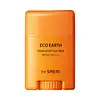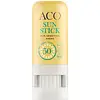What's inside
What's inside
 Key Ingredients
Key Ingredients

 Benefits
Benefits

 Concerns
Concerns

 Ingredients Side-by-side
Ingredients Side-by-side

Synthetic Wax
AbrasiveCaprylic/Capric Triglyceride
MaskingC12-15 Alkyl Benzoate
AntimicrobialSilica
AbrasiveHomosalate
Skin ConditioningDiethylamino Hydroxybenzoyl Hexyl Benzoate
UV FilterButylene Glycol Dicaprylate/Dicaprate
EmollientVinyl Dimethicone/Methicone Silsesquioxane Crosspolymer
Bis-Ethylhexyloxyphenol Methoxyphenyl Triazine
Skin ConditioningEthylhexyl Salicylate
UV AbsorberButyloctyl Salicylate
Skin ConditioningSilica Silylate
EmollientOctocrylene
UV AbsorberCetyl Alcohol
EmollientPoly C10-30 Alkyl Acrylate
Emulsion StabilisingDipropylene Glycol
HumectantGlycerin
HumectantWater
Skin ConditioningEpilobium Angustifolium Extract
Skin ConditioningHydrolyzed Acacia Macrostachya Seed Extract
Skin ConditioningLepidium Meyenii Root Extract
Skin ConditioningMoringa Oleifera Seed Oil
EmollientMaltodextrin
AbsorbentEchium Plantagineum Seed Oil
Skin ConditioningMadecassoside
AntioxidantCentella Asiatica Extract
CleansingAloe Barbadensis Leaf Extract
EmollientDioscorea Japonica Root Extract
Skin ConditioningLaminaria Japonica Extract
Skin ProtectingUlmus Davidiana Root Extract
Skin ConditioningViola Mandshurica Flower Extract
AntioxidantGlycyrrhiza Uralensis Extract
EmollientCnidium Monnieri Fruit Extract
HumectantCentella Asiatica Leaf Extract
Skin ConditioningSolidago Virgaurea Extract
Skin ConditioningRosmarinus Officinalis Leaf Extract
AntimicrobialAdenosine
Skin ConditioningCaprylic/Capric Glycerides
EmollientSorbitan Sesquioleate
EmulsifyingTocopheryl Acetate
AntioxidantPolyglyceryl-10 Oleate
Skin ConditioningHydrogenated Lecithin
EmulsifyingOctyldodecanol
EmollientOctyldodecyl Oleate
EmollientOctyldodecyl Stearoyl Stearate
EmollientButylene Glycol
HumectantAlcohol Denat.
AntimicrobialEthylhexylglycerin
Skin Conditioning1,2-Hexanediol
Skin ConditioningParfum
MaskingSynthetic Wax, Caprylic/Capric Triglyceride, C12-15 Alkyl Benzoate, Silica, Homosalate, Diethylamino Hydroxybenzoyl Hexyl Benzoate, Butylene Glycol Dicaprylate/Dicaprate, Vinyl Dimethicone/Methicone Silsesquioxane Crosspolymer, Bis-Ethylhexyloxyphenol Methoxyphenyl Triazine, Ethylhexyl Salicylate, Butyloctyl Salicylate, Silica Silylate, Octocrylene, Cetyl Alcohol, Poly C10-30 Alkyl Acrylate, Dipropylene Glycol, Glycerin, Water, Epilobium Angustifolium Extract, Hydrolyzed Acacia Macrostachya Seed Extract, Lepidium Meyenii Root Extract, Moringa Oleifera Seed Oil, Maltodextrin, Echium Plantagineum Seed Oil, Madecassoside, Centella Asiatica Extract, Aloe Barbadensis Leaf Extract, Dioscorea Japonica Root Extract, Laminaria Japonica Extract, Ulmus Davidiana Root Extract, Viola Mandshurica Flower Extract, Glycyrrhiza Uralensis Extract, Cnidium Monnieri Fruit Extract, Centella Asiatica Leaf Extract, Solidago Virgaurea Extract, Rosmarinus Officinalis Leaf Extract, Adenosine, Caprylic/Capric Glycerides, Sorbitan Sesquioleate, Tocopheryl Acetate, Polyglyceryl-10 Oleate, Hydrogenated Lecithin, Octyldodecanol, Octyldodecyl Oleate, Octyldodecyl Stearoyl Stearate, Butylene Glycol, Alcohol Denat., Ethylhexylglycerin, 1,2-Hexanediol, Parfum
Ozokerite
Emulsion StabilisingC12-15 Alkyl Benzoate
AntimicrobialDimethicone
EmollientCoco-Caprylate
EmollientBis-Ethylhexyloxyphenol Methoxyphenyl Triazine
Skin ConditioningDiethylamino Hydroxybenzoyl Hexyl Benzoate
UV FilterEthylhexyl Salicylate
UV AbsorberTitanium Dioxide
Cosmetic ColorantVp/Hexadecene Copolymer
Butyl Methoxydibenzoylmethane
UV AbsorberEthylhexyl Triazone
UV AbsorberTribehenin
EmollientCanola Oil
EmollientTocopheryl Acetate
AntioxidantDimethicone Crosspolymer
Emulsion StabilisingPanthenol
Skin ConditioningPolyhydroxystearic Acid
EmulsifyingPhenoxyethanol
PreservativeAlumina
AbrasiveStearic Acid
CleansingPentaerythrityl Tetra-Di-T-Butyl Hydroxyhydrocinnamate
AntioxidantOzokerite, C12-15 Alkyl Benzoate, Dimethicone, Coco-Caprylate, Bis-Ethylhexyloxyphenol Methoxyphenyl Triazine, Diethylamino Hydroxybenzoyl Hexyl Benzoate, Ethylhexyl Salicylate, Titanium Dioxide, Vp/Hexadecene Copolymer, Butyl Methoxydibenzoylmethane, Ethylhexyl Triazone, Tribehenin, Canola Oil, Tocopheryl Acetate, Dimethicone Crosspolymer, Panthenol, Polyhydroxystearic Acid, Phenoxyethanol, Alumina, Stearic Acid, Pentaerythrityl Tetra-Di-T-Butyl Hydroxyhydrocinnamate
Ingredients Explained
These ingredients are found in both products.
Ingredients higher up in an ingredient list are typically present in a larger amount.
You might know this ingredient as Tinosorb S or Bemotrizinol. It is a UV filter that covers both UVA and UVB rays.
This ingredient has two peak UV absorption peaks ( 310 and 340 nm) and is able to absorb both UV-A and UV-B rays. This ingredient works by preventing UV rays from reaching and damaging your skin.
On top of that - it is highly photostable and helps prevent the photodegration of other sunscreen ingredients such as avobenzone.
Tinosorb S is allowed in the EU, Australia, and Asia. It is close to being approved by the FDA and we'll hopefully get this ingredient in the U.S. by late 2025.
Fun fact: Tinosorb S is the most effective UV absorber at maximum concentration (measured by SPF) permitted in the EU.
This ingredient is oil-soluble, so your oil-cleansers will take this right off at night.
Learn more about Bis-Ethylhexyloxyphenol Methoxyphenyl TriazineC12-15 Alkyl Benzoate is made up of Benzoic Acid and long chain alcohols. It has a low molecular weight.
C12-15 Alkyl Benzoate is an emollient and texture enhancer. Due to its solubility, it is often used in sunscreens to help evenly distribute active ingredients.
As an emollient, C12-15 Alkyl Benzoate helps soften and hydrate your skin. Emollients create a film on your skin that traps moisture within.
This ingredient has been reported to cause eye irritation.
Learn more about C12-15 Alkyl BenzoateDiethylamino Hydroxybenzoyl Hexyl Benzoate (DHHB) is a chemical UV-A absorber. It is formulated for high UVA protection (320-400 nm).
DHHB is well-liked for:
DHHB has been approved by the EU, Japan, Taiwan, and South America for use up to 10%. Unfortunately, it has not been approved for use in the US or Canada due to slow regulatory processes.
This ingredient is soluble in oils, fats, and lipids.
Learn more about Diethylamino Hydroxybenzoyl Hexyl BenzoateEthylhexyl Salicylate is an organic compound used to block UV rays. It primarily absorbs UVB rays but offers a small amount of UVA protection as well.
Commonly found in sunscreens, Ethylhexyl Salicylate is created from salicylic acid and 2-ethylhexanol. You might know salicylic acid as the effective acne fighter ingredient and BHA.
The ethylhexanol in this ingredient is a fatty alcohol and helps hydrate your skin, similar to oils. It is an emollient, which means it traps moisture into the skin.
According to manufacturers, Ethylhexyl Salicylate absorbs UV wavelength of 295-315 nm, with a peak absorption at 307-310 nm. UVA rays are linked to long term skin damage, such as hyperpigmentation. UVB rays emit more energy and are capable of damaging our DNA. UVB rays cause sunburn.
Learn more about Ethylhexyl SalicylateTocopheryl Acetate is AKA Vitamin E. It is an antioxidant and protects your skin from free radicals. Free radicals damage the skin by breaking down collagen.
One study found using Tocopheryl Acetate with Vitamin C decreased the number of sunburned cells.
Tocopheryl Acetate is commonly found in both skincare and dietary supplements.
Learn more about Tocopheryl Acetate